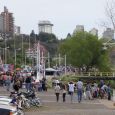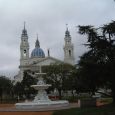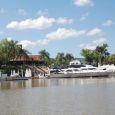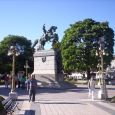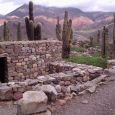Parana
Advertisement
By Air
The General Justo Jose de Urquiza Airport (IATA PRA) is 7.5 kilometres from the city and services regular flights to Buenos Aires.
By Train
Rail development is emerging, dedicated to freight transportation.The port is idle and receives occasional cruises and ships that are passing through.The city is covered by 18 bus lines regulated by the municipality.
By Bus
In this vital road network was the construction of the tunnel Subfluvial Raul Uranga - Carlos Sylvestre Begnis called "Hernandarias" since its opening in 1969 until 2001 and which connects Santa Fe Parana A new bus station and domestic airport connect it with Numerous ground and aerial targets.
Popular Library of Parana
was officially founded on March 1 of 1873 in the city of Parana, Entre Rios.President Domingo Faustino Sarmiento was created in 1870, the Commission Protection of Public Libraries (now CONABIP ), making it one of the popular libraries oldest Argentina.The institution offers the service free public library, as well as hosting numerous presentations in the building arts, culture and education.The current library building opened in 1910, was declared a National Historic Landmark June 28 of 2006 by the Law 26 116.On September 23 of 1870, driven by President Domingo Faustino Sarmiento, the Law 419, which led to the Protection of Public Libraries Committee in order to encourage the creation and development of these institutions, associations formed by individuals, in order to spread the books and culture.It was thus that a group of residents founded the Popular Library Civil Parana.The historian Cesar Blas Perez Colman (who was president of the institution between 1944 and 1949) established the foundation date as May 1 of 1873, although it is believed that the Library and worked there since at least 1872.The first recorded time president is Mr. Right Comas who presided over the institution in the period 1877-1878.The first physical space was the Hall of Sessions of the House of Representatives of the Confederation, where he was and is currently the Normal School of Parana.In 1885, the library moved to the residence of Saturnino Garcia, on the same block as the previous building.
Theatre February 3
is the main theater of the city of Parana in the province of Entre Rios, Argentina.The complex is under the Ministry of Culture of the city and its hall houses of different branches of art shows.Its name refers to the Battle of Caseros occurred on February 3 the year 1852.It was declared a National Historical Monument March 10 of 2008 by Decree 390/2008.The theater's construction began on the initiative of Dean Juan Jose Alvarez and disposal of General Justo Jose de Urquiza, on December 9 of 1851 under the direction of architect Jose Quirce.The opening of the hall was held on August 8 of 1852 attended by 900 guests and proclaimed by the then Governor Antonio Crespo.On December 31 of 1874 the theater became administered by the Municipality of Parana whose creation had occurred on March 23 last year.However, the original building was damaged to 1890 because it was used as the quartering of troops during the revolution.Twenty years later, on October 18th of 1908 was inaugurated the new building, at the same site as above, whose construction was begun during the tenure of Mayor Jose Maria Silva and completed in the period in which Baucis James held the position.The direction of the work fell into the hands of the engineer Lorenzo Siegerist.On May 25th of 1994 the building housed the opening of the National Constituent Assembly in charge of renewing the Constitution of Argentina.
Provincial Museum of Natural Sciences and Anthropology Prof. Antonio Serrano
Gardel is located at 62, opposite the Plaza Alvear (also known as Plaza San Miguel).The museum grew out of the momentum of a group of students that the August 3 of 1917 established the Student Association Pro Folk Museum.In 1924 the General Council of Education of the province appointed Professor Antonio Serrano as its director.A decade later, on December 19 was transformed into Provincial Museum and finally in 1982 was named in honor of Professor Serrano.His collection includes samples of flora and fauna of the region, in addition to numerous anthropological and archaeological pieces.
Martiniano Leguizamon Historical Museum
Founded in 1917 under the name Central School Museum, then called the Museum of Entre Rios, being reorganized in 1948 adopted its present name.It is located in Buenos Aires and Laprida Street, opposite the Plaza Alvear (San Miguel).It has collections and historical items, plus a large library.
Urquiza Park
is the largest park in the city of Parana, capital of the province Argentina of Entre Rios.It comprises an area of 44 acres located northeast of the city along the river bounded by the coastal avenue "Laurencena" Mitre Boulevard, Moreno, Guemes and the Basques.The park is divided into three levels: the Coastal High, Medium and Low connected by numerous stairs, paths and streets that you can go up or down the cliffs into the vegetation.The coast is covered by the coastal avenue Laurencena from Puerto Nuevo to the historic drop in Basque.The amphitheater is built in a natural depression in the area known as Boca del Tigre, in the Coastal Park Media Urquiza.It has capacity for approximately 2,000 people and represent it plays, musicals, films are shown, among other activities.The main entrance is at the height above the depression, where a staircase is divided into two branches for distribution to the public.The stands were projected in the central area at a height below the level of the canyon its axis coinciding with the setting and its slope with the terrain.They are supported directly over the canyon, while avoiding the possible landslides anchors placed concrete.The stage, located in an easy point of view, is circular in shape with the front part to a lower level as a pit orchestra.To the sides and bottom screens there is convex to the reflection of sounds. On one side of it are the cloakrooms and toilets for artists, while for the public toilets are on the sides of the stands at an intermediate level.Projected revenues were also different for artists and authorities in addition to vehicular access to the back room of the stage.
Bajada Grande
is an area located northwest of the city of Parana, on the banks of the river.It is bounded by Avenida Estrada, Antonio Avenue Larramendi and Medina.The largest drop zone was chosen by the first settlers when in the seventeenth century, Santa Fe (capital) should be moved from its first location near Cayasta to its present location.It was also the site where travelers on their way to Corrientes or Paraguay were to continue walking the path of the left bank of Parana.When they built the fort on the site now occupied by the square May 1 the population began to cluster around it, leaving the slope as a landing that over time became an important port for communication of the city.On October 16th of 1896 opened a dock built by the company in the Central Railroad of Entre Rios.
Church of San Miguel
San Miguel Church, located at the corner of Buenos Aires and Carlos Gardel in the middle Parana, is one of the most recognized and oldest in the city.Its name is reminiscent of the employer in the province of Entre Rios.The style is eclectic with influence of gothic.The Temple of San Miguel was built thanks to the initiative of the priest and forced Gil Antolin, who proposed a project in 1822 realizing the religious needs of the northern part of the city known as Barrio del Candombe or Tambor.The building could be built with input from the neighborhood and official support of then Governor Lucio Mansilla.The work was begun on May 14 of that year.The temple has beautiful works of art as the image in the high altar, sculpted by Domenico Genovese Commendatore de Carli, carved in white marble the ceiling paintings made by the Italian Fine and the two figures of the presbytery made approximately 1950 by the Italian Carlos Castellan and Juan Carlos Migliavaca entrerriano.
November - February
May - August


